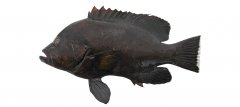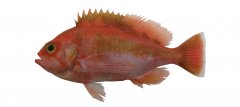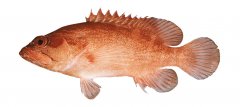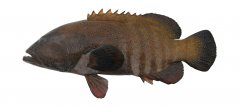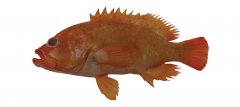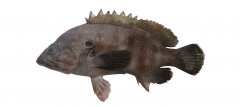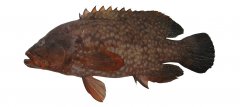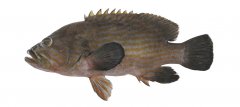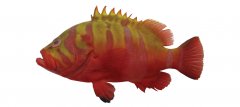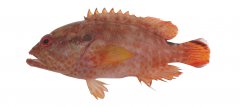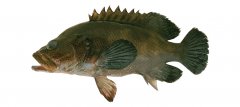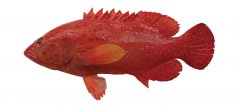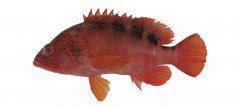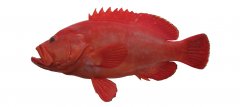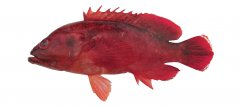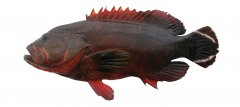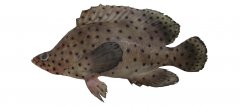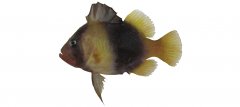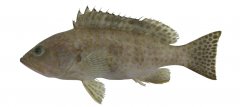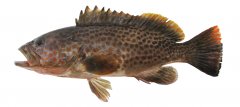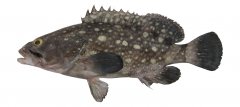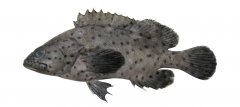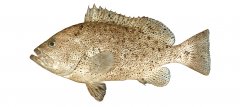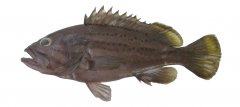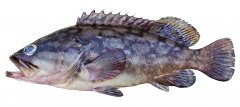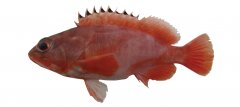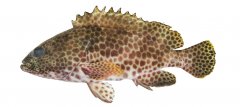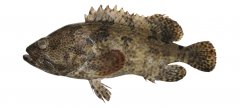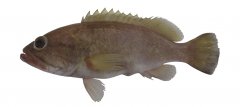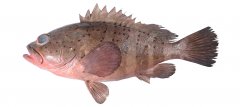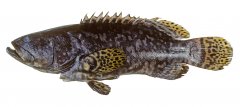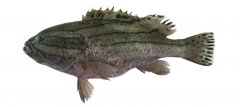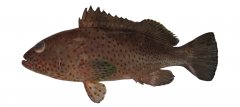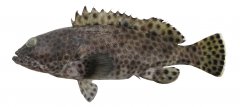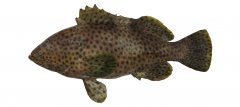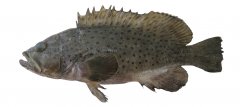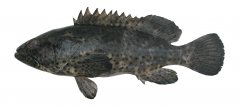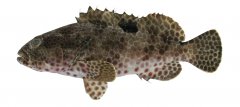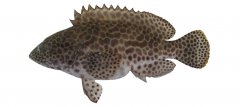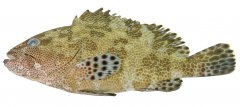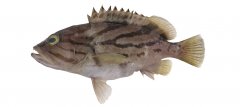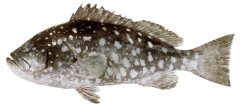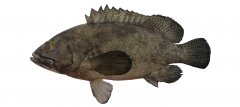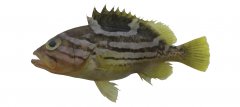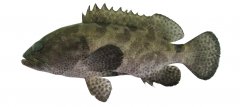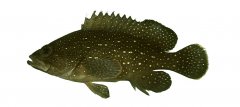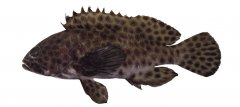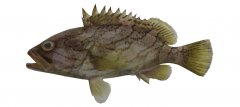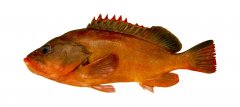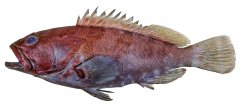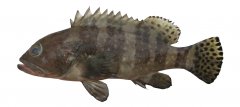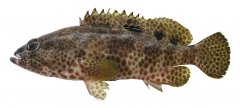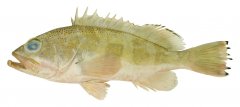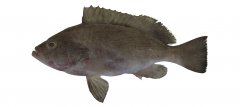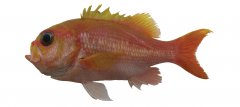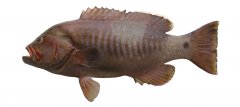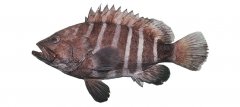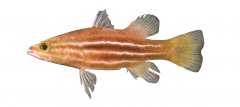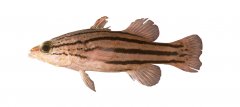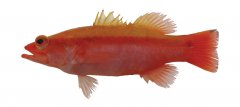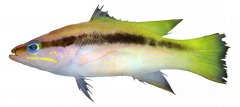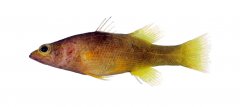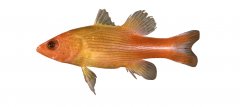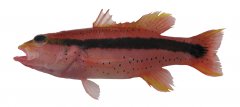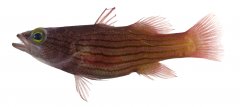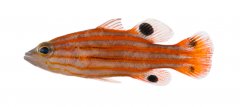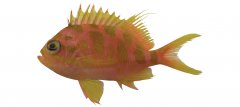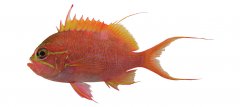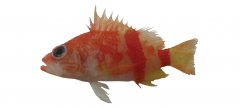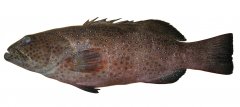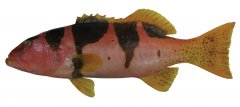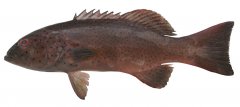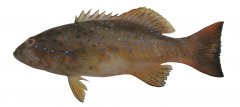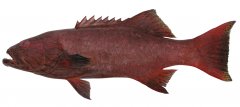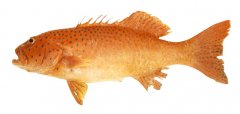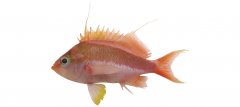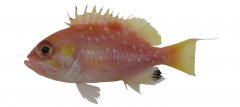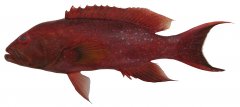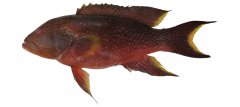All keys adapted from Heemstra & Randall, 19991.
-
- Scaly flap of skin joining base of upper pectoral-fin rays to body (except in Liopropoma) (Fig. 1); dorsal-fin spines 4, or 6–11 (rarely 10) Genera of Epinephelinae
- No scaly flap of skin joining base of upper pectoral-fin rays to body; dorsal-fin spines 8–13 2
-
- Dorsal fin with 10 spines and 9 or 10 soft rays; maxilla naked (Fig. 2a) Serraninae (Chelidoperca)
- Dorsal fin with 10 or 11 spines and 13–20 soft rays or 13 spines and 15 soft rays; maxilla scaly or naked (Fig. 2b) Anthiadinae
-
- No scaly flap of skin joining base of upper pectoral-fin rays to body (Fig. 1a) Liopropoma
- Scaly flap of skin joining base of upper pectoral-fin rays to body (Fig. 1b) 2
-
- Body deep and compressed; usually yellow with a blackish bar through eye and a broader black bar on middle of body (Fig. 2); dorsal-fin spines 8 Diploprion bifasciatum
- Body less deep and not compressed; usually yellow with a dark; colour not as above; dorsal-fin spines 7–11 3
-
- Dorsal-fin spines 7 or 8; lower edge of preopercle with 1–3 enlarged spines (usually hidden by skin, but can be detected by running a finger along preopercle edge) (Fig. 3a) Cephalopholis
- Dorsal-fin spines 9–11; lower edge of preopercle smooth (except for a few species of Epinephelus with 1–4 enlarged serrae) (Fig. 3b) 4
-
- Body and head elongate and markedly compressed, the greatest body width 11–15% of standard length and more than 3 times in head length; no teeth on palatines Anyperodon leucogrammicus
- Body compressed in some species, but its width only 1.8–3 times in head length; palatines with teeth 6
-
- Pectoral fins distinctly asymmetric, the 5th or 6th rays longest (Fig. 7a); dorsal fin with 9 spines and 17 or 18 soft rays; caudal fin truncate (Fig. 8a) Aethaloperca rogaa
- Pectoral fins symmetric or nearly so, the middle rays longest (Fig. 7b); dorsal fin with 9–11 spines and 12–21 soft rays; caudal fin rounded, truncate, or emarginate (Fig. 8b) 8
-
- Body with 8 broad dark bars (Fig. 9) Hyporthodus octofasciatus
- Colour not as above Epinephelus
-
- Caudal fin truncate (Fig. 10a); head small, 2.9–3.2 times in standard length (Fig. 11a); dorsal-fin membranes not incised between spines (Fig. 12a) Gracila albomarginata
- Caudal fin rounded (truncate in Cephalopholis polleni) (Fig. 10b); head length 2.2 to 3.1 times in standard length (Fig. 11b); dorsal-fin membranes distinctly incised between spines (Fig. 12b) Cephalopholis
-
- Caudal fin truncate to slightly emarginate (Fig. 1a); head and body with alternating stripes of blue and orange-yellow; juveniles golden-yellow (Fig. 2); juveniles with black spot on snout in front of eye and black maxillary streak (streak sometimes still evident in adults (Fig. 3)) Cephalopholis polleni
- Caudal fin rounded (Fig. 1b); colour pattern not of alternating stripes of blue and orange-yellow 2
-
- Pelvic fins short, their length 2.3–2.5 times in head length (Fig. 7a); dorsal-fin rays 14; anal-fin rays 8; colour reddish brown with indistinct dark blotch basally on pectoral fins (Fig. 8) Cephalopholis aitha
- Pelvic-fin length 1.5–2.3 times in head length (Fig. 7b); dorsal-fin rays 14–17; anal-fin rays 8–10; colour not as above 4
-
- Small dark spots or dark-edged pale blue spots on head and/or body (Fig. 10a) 6
- No small dark spots or blue ocelli on head or body (Fig. 10b) 7
-
- Dark-edged blue spots only on head and anteriorly on body (Fig. 11a); dorsal-fin rays 14–16 Cephalopholis microprion
- Blue ocelli on head, body, and basally on median fins (Fig. 11b)(juveniles greenish grey, the median fins yellow); dorsal-fin rays 15–17 Cephalopholis cyanostigma
-
- Colour generally brown or yellowish brown, with dark blue lines on head, body, and fins (Fig. 12a); black spot between upper 2 opercular spines (Fig. 13) Cephalopholis formosa
- Body brown, with 7 or 8 more or less distinct dark bars (Fig. 12b); fins dark brown, with a pale blue line at corners of caudal fin (Fig. 14) Cephalopholis boenak
-
- Colour dark brown, covered with small dark-edged blue ocelli (Fig. 15); 5 or 6 pale bars often visible on rear half of body (Fig. 16); dorsal-fin rays 15–17; lower limb of first gill arch with 17–19 gill rakers Cephalopholis argus
- Colour not as above; dorsal-fin rays usually 14 or 15; lower limb of first gill arch with 13–16 gill rakers 9
-
- Colour generally red to reddish brown with widely scattered whitish blotches and sometimes small dark red to reddish brown spots (Fig. 17); juveniles and some adults may be dark purple or brown (Fig. 18); lateral-line scales 66–80; body relatively deep (body depth 2.3 to 2.8 times in standard length) (Fig. 19a) Cephalopholis sonnerati
- Colour not as above; lateral-line scales 45–68; body shallower (body depth 2.6–3.5 times in standard length) (Fig. 19b) 10
-
- Caudal fin blackish red, the corners broadly red, each set off by an oblique white stripe (Fig. 20); lateral-line scales 54–68 Cephalopholis urodeta
- Colour not as above; lateral-line scales 45–56 11
-
- Dark brown saddle spot on caudal peduncle, followed by a smaller spot (Fig. 21); submarginal dark streak at corners of caudal fin (Fig. 22); lateral scale series 79–90 Cephalopholis leopardus
- Colour not as above; lateral scale series 90–121 12
-
- Body with 4 or 5 dark blotches along base of dorsal fin, usually a faint blotch on nape and 2 smaller ones on peduncle (blotches sometimes merging with or being replaced by dark red vertical bars) (Fig. 24a); usually with dark-edged blue lines radiating from eyes Cephalopholis sexmaculata
- No dark blotches on body or blue lines radiating from eyes (Fig. 24b) Cephalopholis miniata
-
- Colour generally orange-yellow to orange-red or golden, with red to orange dots on head and dorsally on body (Fig. 25a) Cephalopholis aurantia
- Colour pale reddish orange, mottled with dark red or brownish red (Fig. 25b) Cephalopholis spiloparaea
-
- Colour brownish grey with yellowish brown dots on head and longitudinal brown lines on dorsal part of body (lines usually lost on large adults) (Fig. 3); gill rakers elongate, no rudiments, 20–23 rakers on lower limb of first gill arch; dorsal-fin rays 17–19 Epinephelus undulosus
- Colour not as above; gill rakers not elongate and rudiments often present, 13–18 rakers on lower limb of first gill arch; dorsal-fin rays 15–17 4
-
- Body without spots or blotches; fins bright yellow (Fig. 4a) Epinephelus flavocaeruleus
- Body with numerous spots or blotches; fins not bright yellow (Fig. 4b) 5
-
- Colour bluish grey with numerous blackish dots (Fig. 5a); large adults with scattered blackish spots and blotches (most smaller than pupil); body depth 2.4–2.7 times standard length (Fig. 6a) Epinephelus cyanopodus
- Colour dark purplish grey with scattered irregular whitish blotches (Fig. 5b); body depth 2.6–2.9 times standard length (Fig. 6b) Epinephelus coioides
-
- Spots absent on head and body or if present dark brown (Fig. 7a); lateral-line scales 64–76 Epinephelus retouti
- Head and at least front of body with small spots, either yellow or brown (Fig. 7b); lateral-line scales 48–54 7
-
- Caudal fin truncate to slightly rounded (Fig. 8a); head, body, dorsal fin, and upper third of caudal fin with small orange-yellow spots (Fig. 9a); lower two-thirds of caudal fin dark grey (without spots) (Fig. 10a); anal and paired fins dusky, without spots (Fig. 11a) Epinephelus bleekeri
- Caudal fin slightly emarginate (Fig. 8b); spots on head, body, and fins yellow or yellowish brown to dark brown (Fig. 9b); entire caudal fin with spots (Fig.10b); paired fins with spots (Fig. 11b) Epinephelus areolatus
-
- Dorsal-fin rays 12–14; juveniles with 2 broad, longitudinal, black-edged whitish bands that disappear in adults (Fig. 12), the dark edges breaking into dashes and spots, which may be lost in large adults (Fig. 13) Epinephelus latifasciatus
- Dorsal-fin rays 14–18; colour not as above 9
-
- Lateral-line scales with branched tubules (Fig. 14); eye small (its diameter about 1/8 and 1/9 head length for specimens 20 and 35 cm length, respectively, and 1/13 head length at 145 cm standard length); interorbital wide (the width more than 1/5 head length for specimens 23–153 cm standard length) Epinephelus lanceolatus
- Lateral-line scales with single tubule (except anterior scales of large E. coioides and E. malabaricus); eye diameter more than 1/7 and 1/8 head length for specimens of 20 and 35 cm length, respectively; interorbital narrower (the width less than 1/5 head length for specimens 23–153 cm standard length) 10
-
- Head and body mostly covered with small dark spots (orange, brown, or black) (Fig. 15a) 11
- No distinct dark spots over most of head and body (yellow or orange spots may be present or there may be some dark dots or scattered small dark spots, but not over most of head and body) (Fig. 15b) 29
-
- Dorsal-fin rays 16–18; dark spots on pectoral fins progressively smaller distally (Fig. 16a); lower jaw not strongly projecting forward (Fig. 17a) Epinephelus faveatus
- No dark spots on distal part of pectoral fins (Fig. 16b); dorsal-fin rays 15–17; lower jaw strongly projecting (Fig. 17b) Epinephelus macrospilos
-
- Dark spots on body elongate, oblique, and more numerous posteriorly; dark spots on head separated by more than 2 spot diameters (Fig. 18a); ventral edge of maxilla of subadults (33–40 cm standard length) with a distinct step that develops into a bony knob in adults (Fig. 19a) Epinephelus longispinis
- Dark spots on body not elongate and not more numerous posteriorly; dark spots on head separated by less than a spot diameter (except E. bontoides) (Fig. 18b); no distinct step on ventral edge of maxilla (Fig. 19b) 15
-
- Two oblique dark brown bands (or elongate dark blotches linked by narrow bands) on chest (Fig. 20); serrae at corner of preopercle distinctly enlarged; pectoral fins large (their length 1.2–1.6 times in head length) (Fig. 21a); dorsal-fin rays 16–18 Epinephelus quoyanus
- No oblique dark bands on chest; serrae at preopercle corner only slightly enlarged; pectoral fins smaller (their length 1.5–2 times in head length) (Fig. 21b); dorsal-fin rays 14–17 16
-
- Head and body with small dark spots separated by spaces greater than 2 spot diameters (Fig. 22a); no dark spots on ventral parts of head and body (Fig. 23a); caudal, soft dorsal, and pectoral fins with a pale yellow to white margin (Fig. 24a); lateral scale series 82–86; total gill rakers on first gill arch 20–22 Epinephelus bontoides
- Dark spots mostly within a spot diameter of adjacent spots (Fig. 22b); spots extending ventrally on head and body (Fig. 23b); fins without a distinct pale margin (Fig. 24b); lateral scale series 92–120; total gill rakers on first gill arch 23–27 (except E. merra with 21–25) 17
-
- Black saddle-blotch on caudal peduncle (Fig. 25); head and body covered by small dark brown or orange-brown spots (Fig. 26); head and dorsal part of body with irregular dark brown blotches superimposed over the dark spots (Fig. 27); dorsal-fin rays 14 or 15; length of longest dorsal-fin spines 2.7–3.3 times in head length (Fig. 28a) Epinephelus polyphekadion
- No black saddle on caudal peduncle; colour not as above; dorsal-fin rays 15–18; longest dorsal-fin spines 2.1–2.7 times in head length (except E. merra, 2.6–2.9 times in head length) (Fig. 28b) 18
-
- Dark brown to black spots on fins (except spinous dorsal fin) much larger than those on body (Fig. 29a); maxilla not reaching vertical at rear edge of eye (Fig. 30a) Epinephelus miliaris
- Dark spots on body slightly larger or subequal to spots on fins (Fig. 29b); maxilla usually reaching to or past vertical at rear edge of eye (Fig. 30b) 19
-
- Some dark brown spots on body often joined to form short bands (Fig. 31a); pectoral-fin rays 16–18; length of longest dorsal-fin spine 2.4–3.2 times in head length Epinephelus merra
- No dark spots joined together on body (Fig. 31b); pectoral-fin rays 17–19; longest dorsal-fin spine 2.1–2.6 times in head length 21
-
- Three close-set pairs of dark brown to black spots on body at base of dorsal fin (Fig. 32a); dorsal-fin rays 17 or 18; lateral scale series 94–102 Epinephelus amblycephalus
- Two large dusky to blackish areas on body and dorsal fin, these separated by a broad whitish (though still faintly spotted) area (Fig. 32b); dorsal-fin rays 15–17; lateral scale series 102–120 Epinephelus maculatus
-
- Most dark spots on body polygonal and close-set, separated only by pale lines (forming a reticulum) or white dots (Fig. 33a); mid-lateral body scales rough 22
- Most dark spots on body round or oblong and well separated (Fig. 33b); midlateral body scales rough or smooth 24
-
- Polygonal dark spots on body separated mainly by white dots at corners of spots (Fig. 34a); elongate yellow-brown blotch behind eye and/or on opercle (Fig. 35a); second anal-fin spine 2.1–2.3 times in head length; longest dorsal-fin spine 2.5–2.8 times in head length (Fig. 36a) Epinephelus hexagonatus
- Dark spots on body separated by network of pale lines (Fig. 34b); no yellow-brown blotch behind eye or on opercle (Fig. 35b); second anal-fin spine 2.4–3.7 times in head length, longest dorsal-fin spine 2.8–3.8 times in head length (Fig. 36b) 23
-
- A single black blotch on body at base of posterior dorsal-fin spines and extending onto fin about half-way to margin (Fig. 37a); caudal peduncle depth 3.2–3.7 times in head length (Fig. 38a) Epinephelus melanostigma
- Three or 4 black blotches at base of dorsal fin and one on top of peduncle; blotch at base of rear dorsal-fin spines not extending half-way to fin margin (Fig. 37b); caudal peduncle depth 3.7–4.3 times in head length (Fig. 38b) Epinephelus spilotoceps
-
- Head and body pale yellowish brown, with irregular dark brown blotches and numerous small close-set dark brown spots (Fig. 39); black saddle spot on caudal peduncle (Fig. 40); mid-lateral body scales of adults smooth; dorsal-fin rays 13–15; total gill rakers on first gill arch 29–31 Epinephelus fuscoguttatus
- Colour not as above; mid-lateral body scales rough; dorsal-fin rays 14–17; total gill rakers on first gill arch 22–29; body depth 2.7–3.7 times in standard length 25
-
- Irregular black spots (less than 1/2 pupil size) on head, body, dorsal fin, and a few on caudal fin (Fig. 41); no spots on ventral parts of head or body or on anal and paired fins (Fig 42); maxilla not reaching past vertical at rear edge of eye (Fig. 43a) Epinephelus magniscuttis
- Colour not as above; maxilla usually reaching past vertical at rear edge of eye (Fig. 43b) 26
-
- Grey, with well-separated black spots smaller than pupil on head, body and fins (Fig. 44); 3 dusky to blackish blotches on body at base of rear half of dorsal fin, the largest at base of last 2 or 3 spines (Fig. 45); juveniles with black-edged white spots on head and body (Fig. 46); rear nostrils (at standard length >14 cm) vertically elongate, their length 2 to 3 times diameter of anterior nostrils (Fig. 47a); pectoral-fin length 1.5–1.7 times in head length (Fig. 48a) Epinephelus corallicola
- Colour not as above; rear nostrils not vertically elongate or more than twice diameter of anterior nostrils (Fig. 47b); pectoral-fin length 1.6–2.5 times in head length (Fig. 48a) 27
-
- Head and body with numerous small well-separated black spots (Fig. 49a); irregular white or pale spots or blotches usually present on head and body (Fig. 49a); spots on head not elongate and not arranged in rows radiating from eye Epinephelus malabaricus
- Head, body, and usually median fins with numerous orange, brownish orange or reddish brown spots (Fig. 49b); no white or pale spots on head or body (Fig. 49b); orange spots become poorly defined and darker with growth; spots on head often coalesce and become elongated, arranged in irregular rows radiating from eye (Fig. 50) Epinephelus coioides
-
- Membranes between dorsal-fin spines usually not incised (some specimens with membranes slightly to moderately incised) (Fig. 51a); head and body dark brown or greenish brown, marbled with irregular pale spots and blotches (Fig. 52); 1 or 2 faint dark streaks running posteriorly from eye (Fig. 53) Epinephelus erythrurus
- Membranes between dorsal-fin spines moderately to deeply incised (Fig. 51b); colour not as above 29
-
- Body pale greyish brown, with 5 dark bars; a narrow pale bar may be present within dark bars, nearly dividing them in 2 (Fig. 54); fins greyish, the median fins with dark spots (Fig. 55); lower limb of first gill arch with 13–15 gill rakers Epinephelus sexfasciatus
- Colour not as above; lower limb of first gill arch with 14–19 gill rakers 30
-
- Body usually with vertical or slightly oblique broad dark bars (faint or absent on some species) (Fig. 56a); dorsal-fin rays 15–18 (rarely 15) 31
- Body without dark vertical bars (Fig. 56b); dorsal-fin rays 13–16 (rarely 16)
-
- Dark orange-brown to black dots (less than 2 mm diameter) on head (behind eye) and body (anteriorly) (Fig. 57a); body with 5 faint, oblique, dark bars (Fig. 58); soft dorsal and caudal fins with narrow dark brown margin (Fig. 59); lateral-line scales 48–51 Epinephelus stictus
- No dark brown to black dots on body or head (some species with black spots, but these are larger than 2 mm) (Fig. 57b,c); lateral-line scales 48–75 32
-
- Margin of interspinous dorsal-fin membranes black (Fig. 60); edge of orbit (around eye) narrowly black, surrounded by pale blue line (Fig. 61); body usually with 5 faint dark bars often containing irregular pale spots (Fig. 62) Epinephelus fasciatus
- Margin of spinous dorsal fin or rim of orbit not black; dark bars on body present or absent 33
-
- Body scales with a whitish dot (Fig. 63); semicircular dark red to reddish brown blotch at base of pectoral fin (Fig. 64); dark pigment in groove along base of spinous dorsal fin (Fig. 65) Epinephelus rivulatus
- Colour not as above 34
-
- Serrae at corner of preopercle only slightly to moderately enlarged (Fig. 66a); dark bars on body oblique (may be faint or absent); body with numerous small pale spots and blotches (Fig. 67a) Epinephelus coeruleopunctatus
- Corner of preopercle with 3–6 large spines (2 or 3 times longer than serrae above corner) (Fig. 66b); dark bars on body vertical or nearly vertical, with black spots on edges (Fig. 67b) 35
-
- Dark U- or V-shaped saddle on nape formed by bifurcation of the pale interface between dark areas (Fig. 68a); dark spots along edges of dark saddle and bars dot-like (Fig. 69a); fins usually with an overall yellow tinge (Fig. 70a) Epinephelus amblycephalus
- No bifurcation on first pale interface, no saddle on nape (Fig. 68b); dark spots along edges of dark saddle larger, not dot-like (Fig. 69b); fins without a yellow tinge (Fig. 70b) Epinephelus kupangensis
-
- Serrae at corner of preopercle slightly to moderately enlarged (Fig. 71a); mid-lateral part of lower jaw with 3–5 rows of teeth in adults; lateral-line scales 48–55; colour pattern of white dots, spots, or blotches (Fig. 72a) 37
- Preopercle corner with 2–5 distinctly enlarged serrae (Fig. 71b); mid-lateral part of lower jaw with 2 rows of teeth in adults; lateral-line scales 52–72; colour pattern not as above (Fig. 72b) 38
-
- Head, body, and fins dark brown with numerous whitish dots (Fig. 73a); no black streak above upper jaw; rear margin of pelvic and pectoral fins narrowly orange-red (Fig. 74); lateral scale series 81–91; snout length 4.8–5.2 times in head length (Fig. 75a) Epinephelus polystigma
- Head, body, and fins dark grey-brown with less distinct pale spots and blotches (Fig. 73b); black streak above upper jaw (Fig. 76); lateral scale series 95–110; snout length 4.0–4.8 times in head length (Fig. 75b) Epinephelus ongus
-
- No dark or light markings on body; yellowish brown stripe from eye to opercular flap and 2 similar bands on cheek, the lower runs posteriorly from end of maxilla (Fig. 77a); lateral scale series 89–100 Epinephelus heniochus
- Body with dark brown bands and/or spots (Fig. 77b); lateral scale series 102–125
-
- Body with long curved dark brown bands or series of spots, the middle of each band or row of spots more ventral than the ends (Fig. 78a) 40
- Dark markings not as above (Fig. 78b) 41
-
- Large oval dark brown blotch (or group of small spots on larger specimens) on body at base of middle dorsal-fin spines, this blotch not joined to lower dark bands (Fig. 79a); broadly curved dark bands or rows of spots on head and body paralleling curvature of isolated dark blotch (Fig. 80a); dark markings faint or absent on large adults Epinephelus poecilonotus
- Dark brown blotch on body at base of middle dorsal-fin spines joined to dark brown band passing to upper edge of operculum (Fig. 79b); a second dark band from upper end of gill opening, bifurcating above pectoral fin, with branches to anterior and posterior dorsal-fin rays (Fig. 80b) Epinephelus morrhua
-
- Head and body with almost horizontal dark bands, upper bands bordered with dark spots (Fig. 81a); body depth 3.0–3.3 times in standard length Epinephelus epistictus
- Head and body with intricate pattern of irregular dark lines, spots, and blotches (Fig. 81b); body depth 2.6 to 3.0 times in standard length Epinephelus radiatus
-
- First gill arch with 8 gill rakers on upper limb, and 19 or 20 (only 2 rudiments) on lower limb; pectoral-fin rays 14; dorsal-fin rays 11 or 12; caudal fin truncate to slightly rounded (Fig. 2a); no scales on front of snout or on preorbital; head and body with 6 or 7 broad dark stripes; prominent dark ocellus in soft dorsal and anal fins (Fig. 3a) Liopropoma swalesi
- First gill arch with 5–7 gill rakers on upper limb, and 11–16 (including 9–12 rudiments) on lower limb; dorsal-fin rays 12–14; caudal fin slightly to deeply emarginate (Fig. 2b); head covered with scales; no dark stripes on body; no ocelli in fins (Fig. 3b) 3
-
- Last dorsal-fin spine shorter than 6th and 7th spines; caudal fin with broadly rounded corners (Fig. 4a); anterior nostril tube not reaching lip; upper surface of body yellow; no dark midlateral stripe on sides (Fig. 5a); anal-fin rays 9; pectoral-fin rays 15 or 16 Liopropoma dorsoluteum
- Last (8th) dorsal-fin spine longer than 6th and 7th spines; caudal fin corners pointed (Fig. 4b); anterior nostril tube overlaps upper lip; upper surface of body without a distinct yellow area; a distinct dark midlateral stripe on sides (Fig. 5b); anal-fin rays 8; pectoral-fin rays 14 or 15 4
-
- Numerous black semicircular spots above and below the midlateral stripe (Fig. 6a); first anal-fin spine relatively short (its length 10.4–12.2 in head length Liopropoma randalli
- No small black spots on body (Fig. 6b); first anal-fin spine longer (its length 8.2–8.3 in head length) Liopropoma lemniscatum
-
- Head and body with three distinct, narrow white stripes (Fig. 7) Liopropoma africanum
- Colour not as above 6
-
- Body with 6–8 dark stripes (Fig. 9a); pectoral-fin rays 15 or 16 Liopropoma susumi
- Body with 4 or 5 dark stripes (Fig. 9b); pectoral-fin rays 14 or 15 Liopropoma collettei
-
- Body red to brownish red, often with faint lines following scale rows (Fig. 10a); yellow stripe from front of snout to eye, another between eyes, and 1 to 3 running posteriorly from eye (Fig. 11); scales rarely extend dorsally on snout more than half-way from rear nostrils to upper lip Liopropoma mitratum
- Body yellowish anteriorly becoming red posteriorly with a white midlateral stripe extending onto caudal fin (Fig. 10b); scales dorsally on snout extend more than half-way from rear nostrils to upper lip Liopropoma multilineatum
-
- Anterior rays of soft dorsal and anal fins elevated, the fin margin with a distinct lobe anteriorly (longest dorsal-fin rays 1.6–2.1 times in head length) (Fig. 1a); adults with horizontal to oblique blue lines on side of head Plectropomus oligacanthus
- Anterior rays of dorsal and anal fins not elevated to form a lobe (longest dorsal-fin rays 2.2–3.2 times in head length) (Fig. 1b); adults not coloured as above (Fig. 2) 2
-
- Head, body, and median fins covered with close-set, round to slightly oval, dark-edged blue spots, distance between spots subequal to spot diameters (Fig. 3a); caudal fin truncate to slightly emarginate, the caudal concavity (difference between lengths of longest (upper) ray and shortest (middle) rays) 13 or more times in head length (Fig. 4a); interorbital area with small embedded scales Plectropomus areolatus
- Head and body with round to oblong blue spots not obviously black edged, distance between spots greater than spot diameter (Fig. 3b); or with black saddle-like blotches along upper body, sometimes with spots (Fig. 3c); caudal fin emarginate, the caudal concavity 5–12 times in head length (Fig. 4b); no scales on interorbital area 3
-
- Head and body pale, with 4 or 5 saddle-like dark brown or black blotches and a few small blue spots, the fins yellow (Fig. 5a); or head and body brownish with numerous small blue spots and with or without faint dark saddle blotches (Fig. 5b); caudal-fin length 1.5–1.8 times in head length (Fig. 6a) Plectropomus laevis
- No dark saddle-like blotches on body (Fig. 5c); caudal fin length 1.3–.5 times in head length (Fig. 6b) 4
-
- Head and body covered (except ventrally) with small blue spots, about size of nostrils, the distance between spots more than twice their diameter; spots not elongate (Fig. 7a) Plectropomus leopardus
- Most blue spots on head and body more than twice size of nostrils; some spots on head and body elongate (except juveniles) (Fig. 7b) 5
-
- Pelvic fins without blue spots (Fig. 8a); some spots on body of adults horizontally elongate (Fig. 9a); nostrils subequal in size Plectropomus maculatus
- Pelvic fins with blue spots (Fig. 8b); some spots on body of adults vertically elongate (Fig. 9b); rear nostrils of adults >50 cm standard length distinctly larger than anterior nostrils Plectropomus pessuliferus
-
- Rear margin of caudal fin with a black submarginal line and narrow white edge and dorsal, anal, and pectoral fins without a distinct yellow posterior border (Fig. 1a); pelvic fins usually not reaching anus (Fig. 2a); juveniles without a dark stripe on body dorsally and no dark spot at base of upper caudal-fin rays Variola albimarginata
- Caudal, dorsal, anal, and pectoral fins with a broad yellow rear margin (Fig. 1b); pelvic fins reach beyond anus (Fig. 2b); juveniles with irregular dark brown stripe along dorsal part of body and a dark spot at base of upper caudal-fin rays (Fig. 3) Variola louti
Lutjanidae
Snappers

Lutjanidae differs in having maxilla mostly covered by preorbital bone when mouth is closed (vs. maxilla exposed when mouth is closed); no spines on opercle (vs. three flat opercular spines) and scaly axillary process at base of pelvic fins usually well developed (vs. scaly axillary process at base of pelvic fins).
Sparidae
Sea bream
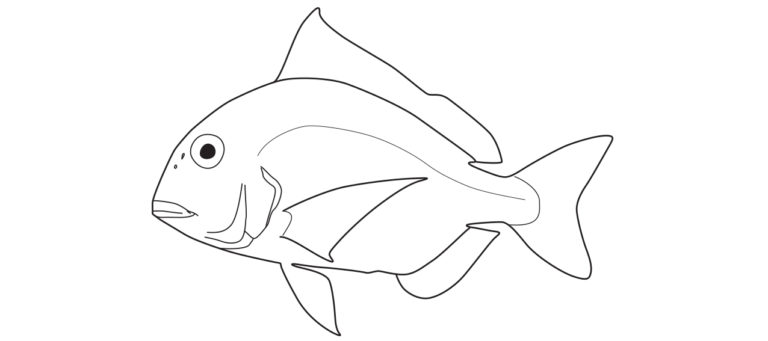
Sparidae differs in having jaws with incisiform and/or molariform teeth (vs. small slender teeth and usually canines); maxilla mostly covered by preorbital bone when mouth is closed (vs. maxilla exposed when mouth is closed); no spines on opercle (vs. three flat opercular spines) and edge of preopercle smooth (vs. usually serrate).
- Heemstra, P.C. & Randall J.E. Serranidae. in: Carpenter, K, Niem, V. FAO species identification guide for fishery purposes. The living marine resources of the Western Central Pacific. Volume 4. Bony fishes part 2 (Mugilidae to Carangidae). Rome: 1999; Volume 4; 2069-2790.
